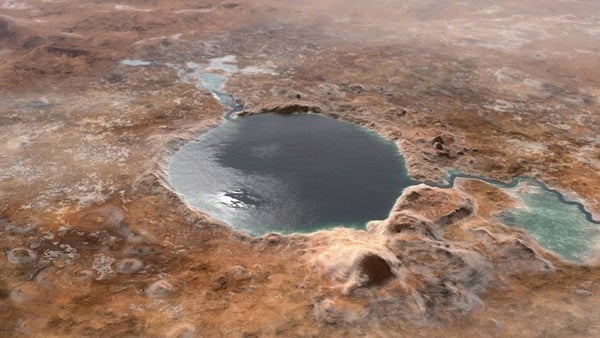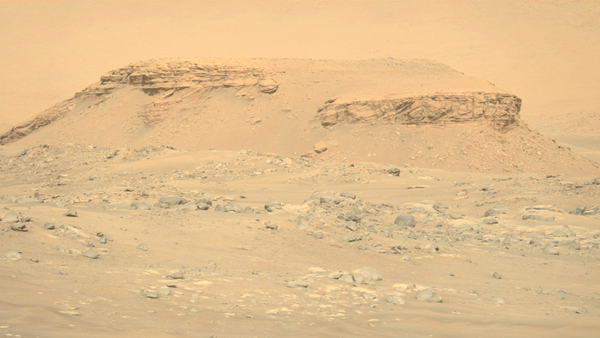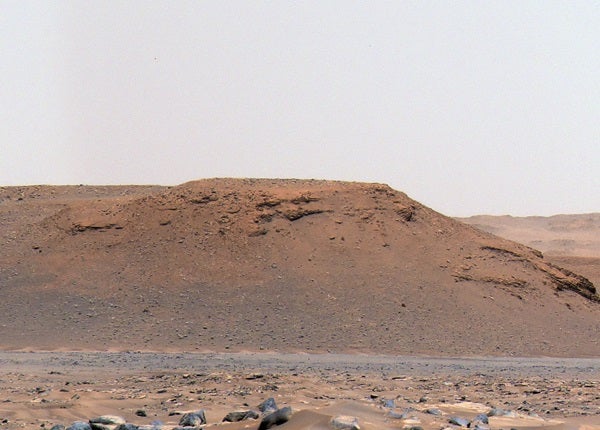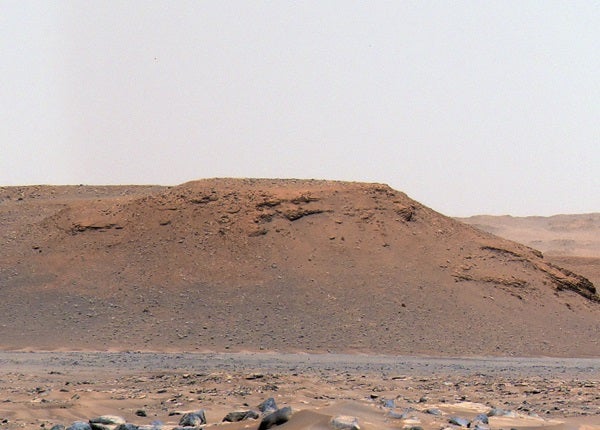NASA’s Perseverance rover has spent the last eight months in the dry, forlorn landscape of Jezero Crater. But analysis of some of the rover’s first images have confirmed that roughly 3.7 billion years ago, the crater was home to an ancient lake fed by a river — one that occasionally experienced flash floods, washing boulders into the lake from up to tens of miles away.
When scientists chose Jezero Crater as the landing site for Perseverance, it was precisely because the site bore the hallmarks of an ancient lake. In its northwest corner, a channel leading into the crater ends with a fan-shaped plateau — clear evidence of a river depositing sediment into the lake, forming a delta. Now, scientists know for sure, marking their first efforts at reconstructing the history of this lost waterscape.
“This is the key observation that enables us to once and for all confirm the presence of a lake and river delta at Jezero,” said Nicolas Mangold, the paper’s lead author and a researcher at the Laboratories de Planétologie et Géodynamique in Nantes, France, in a NASA statement.
Reading the rocks
The research, published Oct. 7 in Science, is based on images taken during the rover’s first three months in Jezero by two of its cameras — Mastcam-Z and the SuperCam Remote Micro-Imager (RMI).
These cameras were able to zoom in on two regions roughly 1.3 miles (2.2 kilometers) away from the rover that contained exposed rocky outcrops that were not visible from orbit. Today, they look like buttes or cliffs, but their layers contain a geological record of bedrock that once lay on the bottom of Jezero’s lake.
One of these features, named Kodiak, is a butte west of the rover with exposed rock layers up to 25 meters high. Several places on the butte feature a distinct structure: a set of layers at a slanted angle, sandwiched between parallel rock layers above and below. “Never before has such well-preserved stratigraphy been visible on Mars,” said Mangold.
These slanted rock layers — known as foresets — are characteristic of former river deltas: As a river dumps mud and clay into a body of water, that sediment builds up and forms an underwater fan-shaped mound that drops off sharply away from shore. Those underwater slopes eventually become angled rock layers, like those at Kodiak. These features can’t be explained by wind erosion, the team says, confirming that Jezero was truly a lake.
To the northwest of Perseverance’s landing site lies the second area featured in the study: the wall of the river delta itself, rising 60 meters above the crater floor, with four different outcrops visible from the rover’s vantage point. But what surprised mission researchers was that while the lower levels are made of fine-grained, angled rock layers — similar to those at Kodiak — on top of them was a layer that included “boulders up to 5 feet across that we knew had no business being there,” said Mangold. It looks as if they were simply dumped in place — carried by a flooding river, not a slow and steady one.
Jezero’s history
Taken together, the various outcrops at the delta paint a broad outline of the history of Jezero’s lake. The lowest — and oldest — sediment that makes up the delta was deposited by a river that flowed steadily into Jezero crater, slowly building up the delta over time.
But at some later time, this stable flow was interrupted by episodes of flash flooding. Based on spectral analysis of the boulders, they appear to be a match for a region in the northern highlands, as far as tens of miles away. These floodwaters would have flowed at 4 to 20 mph (6 to 30 km/h), the team estimates.
These ancient martian floods could have been triggered by intense rainfall, or a sudden melt of snow, perhaps due to a volcanic eruption or a meteor impact. Another option is that the floods were caused by glacial lakes suddenly bursting through their natural dams.
Later still, the water level of the lake fell until it was no longer overflowing the crater. It was then that the river laid down the sediment layers at Kodiak. The elevation of the foresets at Kodiak varies, suggesting that the water level of the lake experienced short-term fluctuations, rising and falling as the climate and inflowing river conditions changed.
In addition to unpacking the history of Jezero Crater, the findings also will help mission scientists plan the rest of the mission — especially when it comes to collecting and caching samples that will one day be returned to Earth.
To search for signs of ancient life, the mission team will direct Perseverance to the fine-grained material in the lower rock layers — the steady buildup of material may have preserved organic matter or other biosignatures.
On the other hand, drilling cores from the large boulders in the higher layers will give researchers the chance to sample material from outside of Jezero itself without having to leave the crater. These rocks will be older than those that formed in the impact itself and could offer insight into the ancient Martian interior.













